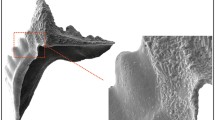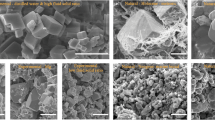Abstract
Quantitative data from four shallowly buried and tectonically undisturbed Paleozoic limestones show that twin lamellae develop preferentially in large and irregularly shaped, non-equant crystals. Frequency of lamellae increases with length/width ratio of crystals, and lamellae are more abundant in larger crystals than in small ones. Because burial cements commonly consist of large crystals that fill non-equant remnant voids, these morphologic controls can cause burial cements to undergo preferential twinning. Morphological control on twinning thus causes the seeming paradox of untwinned early cements accompanied by twinned late cements.
Comparison of data from this study of undeformed shallowly buried rocks with data from other limestones shows that frequencies of twinning in undeformed rocks are less than those of tectonically deformed rocks. However, frequencies of lamellae in shallowly buried limestones overlap with those in limestones that have undergone deep burial diagenesis. Thus spacing of lamellae alone is probably not a sufficient criterion by which to recognize deep burial diagenesis.
Similar content being viewed by others
References
ADLER, F.J., 1987, Mid-Continent Region Correlation Chart: Amer. Assoc. Petrol. Geol. COSUNA Correlation Chart Series.
BRBER, D.J., AND WENK, H.-R., 1979, Deformation twinning in calcite, dolomite, and other rhombohedral carbonates:Phys. Chem. Minerals., v. 5, p. 141–165.
BORAK, B., AND FRIEDMAN, G.M., 1981, Textures of sandstones and carbonate rocks in the world’s deepest well (in excess of 30,000 ft. or 9.1 km) Anadarko Basin, Oklahoma:Sedimentary Geology, v. 29, p. 133–151.
BORG, I., AND TURNER, F.J., 1953, Deformation of Yule Marble: Part VI-Identity and significance of de formation lamellae and partings in calcite grains:Bull. Geol. Soc. Amer., v. 64, p. 1343–1352.
FRIEDMAN, G.M., 1975, The making and unmaking of limestones or the downs and ups of porosity:Jour. Sed. Petrology, v. 45, p. 379–398.
FRIEDMAN, G.M., 1987a, Vertical movements of the crust: Case histories from the northern Appalachian Basin:Geology, v. 15, p. 1130–1133.
FRIEDMAN, G.M., 1987b, Deep-burial diagenesis: its implications for vertical movements of the crust, uplift of the lithosphere and isostatic unroofing — a review:Sedimentary Geology, v. 50, p. 67–94.
FRIEDMAN, G.M., AND SANDERS, J.E., 1982, Time-temperature-burial significance of Devonian anthracite implies former great (~6.5 km) depth of burial of Catskill Mountains, New York:Geology, v. 10, p. 83–96.
FRIEDMAN, M., AND CONGER, F.B., 1964, Dynamic interpretation of calcite twin lamellae in a naturally deformed fossil:Journal of Geology, v. 72, p. 361–368.
FRIEDMAN, M., AND STEARNS, D.W., 1971, Relations between stresses inferred from calcite twin lamellae and macrofractures, Teton anticline, Montana:Geol. Soc. Amer. Bull., v. 82, p. 3151–3162.
FRIEDMAN, M., AND HEARD, H.C., 1974, Principal stress ratios in Cretaceous limestones from Texas Gulf Coast:Amer. Assoc. Petrol. Geol. Bull., v. 58, p. 71–78.
MARSHAK, S., AND ENGELDER, T., 1985, Development of cleavage in limestones of a fold-thrust belt in eastern New York:Journal of Structural Geology, v. 7, p. 345–359.
RAILSBACK, L. B., 1993a, Contrasting styles of chemical compaction in the Upper Pennsylvanian Dennis Formation in the Midcontinent region, U.S.A.:Jour. Sed. Petrology, v. 62, p. 61–72.
RAILSBACK, L., 1993b, Lithologic controls on morphology of pressure dissolution surfaces (stylolites and dissolution seams) in Paleozoic carbonate rocks from the mideastern United States:Jour. Sed. Petrology, v. 63, p. 513–522.
SIMONSEN, J.M., AND FRIEDMAN, G.M., 1992, Closely spaced twin lamellae in limestones as an indicator of deep-burial diagenesis:Carbonates and Evaporites, v. 7, p. 38–47.
STEARN, C.W., CARROLL R.L., AND CLARK, T.H., 1979, Geological Evolution of North America: New York, John Wiley & Sons, 566 p.
TURNER, F.J., 1953, Nature and dynamic interpretation of deformation lamellae in calcite of three marbles:Amer. Jour. Sci., v. 251, p. 276–298.
TURNER, F.J., AND CH’IH, C.S., 1951, Deformation of Yule Marble: Part Ill-Observed fabric changes due to deformation at 10,000 atmospheres confining pressure, room temperature, dry:Bull. Geol. Soc. Amer., v. 62, p. 887–906.
WENK, H.-R., BARBER, D.J., AND REEDER, R.J., 1983, Microstructures in carbonates. in Reeder, R.J., ed., Carbonates: Mineralogy and Chemistry:Mineral. Soc. Amer. Reviews in Mineralogy, v. 11, p. 301–367.
Author information
Authors and Affiliations
Rights and permissions
About this article
Cite this article
Railsback, L.B. Control of crystal shape and size on formation of twin lamellae in calcite: Implications for deep burial diagenetic fabrics in limestones. Carbonates Evaporites 8, 156–162 (1993). https://doi.org/10.1007/BF03175173
Received:
Accepted:
Published:
Issue Date:
DOI: https://doi.org/10.1007/BF03175173




